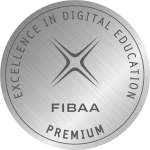Introduction
The success of an e-book hinges not only on the quality of its content but also on its user-friendliness and the inclusion of features that facilitate student engagement with the material. In this article, we explore the fundamental elements incorporated in the e-books offered at Swiss Connect Academy (SCA) by highlighting their ease of use and their ability to enrich the digital learning journey.
To truly understand the effectiveness and needs of the e-books at Swiss Connect Academy, it’s essential to center our approach around those who use them the most: the learners. We prioritize placing the learners at the core of the e-book creation process. Participants feedback, information gathered from surveys, and testing contribute significantly to our understanding of how learners are utilizing the e-books. Through these valuable sources, we gain insightful perspectives on the students’ needs and areas that require improvement. The insights serve as our guiding light ensuring that we continuously move in the right direction.
At Swiss Connect Academy, simple does not equal simplistic.
We prioritize simplicity, consistency, and clarity in e-book layout and navigation, avoiding unnecessary complexity while retaining useful features. A well-structured visual hierarchy and design consistency are the key to fostering a sense of familiarity and ease of use. We maintain a consistent design language throughout the e-books, ensuring that learners encounter a predictable and harmonious experience across the different modules and courses. Here are four ways in which our eBooks stimulate engagement and enhance the depth of learning:
1. SCA incorporates interactive elements in a balanced way to engage participants. One such element is the Learning Journal, which is found at the beginning of each e-book and contains several text boxes corresponding to the number of weeks a module takes to complete. The Learning Journal invites students to write down, after each week of learning (or each chapter, in earlier e-book versions), their reflections on how the acquired knowledge & skills apply to their working life. From an educational perspective, writing in the Learning Journal requires students to actively engage with the material rather than consume it passively. Each student has a unique way of interpreting information; writing down their leanings is a reflection prompt and helps them take more ownership of the content. One way in which we are enabling our students to navigate effortlessly through the e-books’ content is by incorporating hyperlinks to connect certain exercises with the Learning Journals. In this way, students are reminded and sent directly to the Learning Journal to write their takeaways and observations.
2. Another element that adds interactivity to our e-books is the downloadable resources we provide to our students, such as readings and summaries. By condensing information into a one- or two-page file, students can gain a clearer understanding of the overall structure and key points of the chapter. Saving these resources on their own devices enables learners to have access to the content in more locations that they can revisit. In this way, the summaries serve as valuable references for future study and provide an accessible way to quickly review and reinforce their knowledge even outside the dedicated learning time.
3. Interactive SCA exercises enable students to write and save their answers in a dedicated text box. The saved responses can be accessed later in the notebook section, serving as a resource for students to engage in self-assessment and review any knowledge gaps they may have. Furthermore, their answers can be downloaded as a PDF file. This feature adds extra convenience and portability, enabling students to keep a record of their work and monitor their progress over time effectively.
4. To facilitate comprehension and enhance the reading experience, students can interact with the content anywhere in the e-book by using the note-taking functionality. This feature allows them to comment and make personal notes they wish directly on a sentence, a chapter, or anywhere else in the e-book. In this way, students can add personal annotations, highlight key points, explain certain notions, or just write down their thoughts.
Accessibility and Inclusivity Considerations:
We understand the significance of accessibility and inclusivity. Below, we outline how our e-books enhance opportunities for students to engage with our content. By incorporating font-size controls and zooming options, our e-books empower users to adjust the text fonts according to specific needs. This flexibility ensures that readers with visual impairments can enjoy an optimal reading experience.
Marking important sentences with colored highlights can also come in handy, the feature allows quickly locating and revisiting important sections of the e-books. In this way, colored highlights serve as visual cues, providing an intuitive and efficient method of navigation and comprehension.
One of the most effective ways to make e-books accessible for individuals with visual impairments or reading difficulties is through text-to-speech. This technology converts written text into spoken words, allowing users to listen to the content rather than read it, in this way, our e-books promote a welcoming and language-inclusive environment.
To speed up the accessibility of the content even more, students can look up difficult or unknown concepts on Google or Wikipedia by simply clicking on the word or sentence and then on the Wikipedia or Google look-up button.
SCA’s e-books are adapted for optimal performance on mobile devices. While our data indicates that most students access our e-books on desktop devices, we recognize the significance of ensuring mobile optimization. We understand that a good user experience should be accessible across a wide array of devices. Our e-books have been built using reflowable layouts to ensure the pages fit smaller screen sizes and touch interactions in mind. They are built to be responsive and adaptable, providing an optimized viewing experience regardless of the device’s screen resolution. Moreover, we have taken into consideration the importance of loading speed, particularly for learners using older models of tablets and mobile devices. In this way, we enhance the mobile learning experience and facilitate accessibility for users who rely on mobile devices as their primary means of accessing our content.
Continuous Improvement and Iterative Development
To ensure the best learning experience for each new cohort of students, we follow a process of revising our e-books before the start of each course, as described in the following lines. The process involves conducting quality checks and incorporating valuable user feedback gathered from previous cohorts or surveys, covering all aspects of our e-books, including content, interactive elements, and navigation. Since we offer our e-books in three different languages (French, German, and Italian), we place great emphasis on ensuring consistency across all language versions. To achieve this, we regularly perform reviews and tests on various devices and platforms, allowing us to identify and address any issues or inconsistencies. This meticulous approach guarantees standardized e-books that maintain the same high quality across all languages.
Conclusion
Balancing simplicity with feature-rich elements, SCA’s e-books blend the content with a user-centric design that addresses diverse learning needs. Central to this is our dedication of placing students at the heart of the e-book creation process. Through ongoing feedback, surveys, and testing, we unlock nuanced insights, ensuring that every e-book is more than just readable—it’s interactive, engaging, and accessible.
As we navigate the ever-evolving landscape of e-learning, we remain dedicated to enhancing the e-book experience, ensuring our objective is to optimize the accessibility, interactivity, and user-friendliness of our e-books, enhancing the way students interact with the educational materials.









